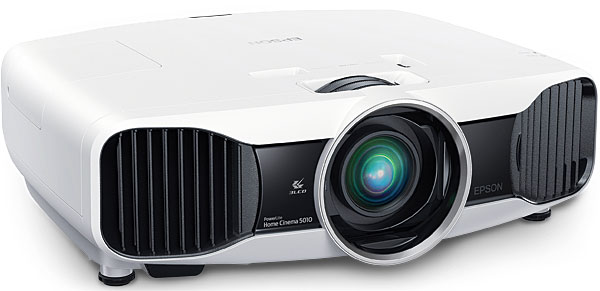Epson PowerLite Home Cinema 5010e 3D LCD Projector

Last year, we started seeing the first 3D projectors hitting the market, and most of these were reserved for the mid- to high-end customer. This year, we’re seeing a trickle-down effect from the high-end manufacturers, plus a lot of the more value-oriented brands that are stepping into the 3D arena. Epson is at the forefront of the latter with a few new options in its PowerLite Home Cinema lineup. For this review, I got the chance to spend some time with its new PowerLite Home Cinema 5010e, a 1080p- resolution LCD projector that brings 3D capability to the Epson line for the first time.
The Goods
The PowerLite Home Cinema 5010e sports a completely new build and look from last year’s Epson models. The case is an attractive white and black, and the center-mounted lens is recessed with a protective door that slides in front of the lens when you turn off the power. It uses Epson’s own 1920 x 1080 LCD panels that are capable of frame rates up to 480 hertz. The review unit sports the “e” moniker because of the wire- less HDMI transmitter that is included in the box. The trans- mitter converts the HDMI signal to Wi-Fi and the projector decodes it for playback, eliminating the need to run an HDMI cable from your rack to the pro- jector. I tried it out and saw no obvious shortcomings, but since I already had HDMI cables run, I typically stuck with the more traditional approach. This is a handy feature for those installing a new projector, as it eliminates long cable runs or having to cut into walls or ceilings.
Epson uses a custom Fusion 2.1 zoom lens that can be controlled via the top panel manual dials. I was a bit disappointed to see there was no support for powered lens control, but at this price point, powered lens adjustments are not common. There are dials for lens shift and focus/zoom. Focusing the 5010e was easy enough, but out-of-the-box I did see some obvious convergence issues from the LCD panels. Epson offers a panel alignment system that was very similar to the one I recently used in my review of the Sony VW-VPL95ES (March 2012), which allows for very fine adjustment of the panels to keep convergence errors to a minimum. Because this is done in processing (the panels themselves are not actually physically aligned), you do take a little bit of a hit in the overall resolution capabilities of the projector when it’s used. You’ll have to decide whether to activate this feature based on the amount of misconvergence. Our review sample’s red panel was off by over a full pixel, so I chose to use the panel-adjustment feature because, without it, fringing was obvious even from my seating position.
Epson offers five different preset picture modes to work with for 2D and two picture modes for 3D. There are quite a few adjustments available so you can get the most out of the image and calibration, far more than I’m used to seeing at this price point. Not only does the 5010e feature adjustments for grayscale, but also a full color-management system (CMS) for all primary and secondary color points, and a decent gamma point adjustment with presets that are already quite good.
Speaking of calibration, I was very pleased with the performance of the 5010e in this regard. Using the Natural picture mode with the color temperature set to 6500, the out-of-box grayscale tracking was off quite a bit. But I was able to dial in a respectable grayscale with a very linear gamma of about 2.3. I barely needed to use the CMS because once the grayscale was dialed in, the color points were nearly spot on, although I did do some minor tweaking.

I ran into an interesting issue in regard to calibration. The 5010e saves its settings based on the incoming color space. So if your calibration was done with an RGB source, the settings won’t stay for a YCbCr source. This was frustrating early on because I couldn’t figure out why the settings weren’t staying the same with different picture material. Another caveat also worth mentioning is color clipping. Using the clip charts on the Spears & Munsil High-Definition Benchmark Blu-ray, the color boxes showed clipping regardless of where I set the contrast, but white levels were retained properly. I also saw some rolloff in both color and luma detail.
The 5010e uses an auto-iris system to improve its contrast performance. This is becoming a pretty common feature among projectors, but we do see some obvious differences in performance from model to model. The 5010e’s auto iris features two modes: Normal and High Speed. Typically, dynamic-iris systems control an iris in the light path and also adjust gamma to keep average picture levels nearly the same. Some systems are better than others; potential drawbacks include clipping, image pumping, and dynamic compression in the brighter areas of a picture. While the auto iris did improve the visible black performance of the 5010e, it also had issues. Most notable was a significant effect on grayscale. With the auto iris engaged, the upper white levels clipped immediately, and the white balance took a pretty significant drift toward red. This was very noticeable with test patterns, but not as obvious with normal viewing material, so mileage may vary. The iris itself is also slightly clunky, and makes more audible noise than any projector I’ve used before with this feature. While I didn’t usually notice it at normal listening volumes, it could sometimes be heard during silent passages in the program source.
In its Normal mode, the dynamic iris closes down very slowly on dark scenes. This is not unusual; we’ve seen it in dynamic irises on other projectors. It’s done to make the operation of the iris less visually obvious. But as the Epson’s iris reaches the brightness level at the bottom end required by the source, the grayscale shifts significantly toward red. This is also the case in the Fast iris setting, where it’s also accompanied by visible brightness pumping that’s not present in the Normal mode.

LCD projectors in general have lower native-contrast ratios than other display technologies, such as LCOS or DLP. Using a dynamic-iris system is a necessity to get the best contrast performance. The best contrast measurement I could get from the 5010e without the use of the dynamic iris was 3,200:1 on/off. This was with the bulb in ECO mode, which delivered about 13 foot-lamberts on my Stewart Filmscreen StudioTek 130 screen (120-inch diagonal, 1.3-gain, 16 x 9). Using the dynamic iris resulted in a peak on/off contrast of 105,200:1, but only if I let the iris settle all the way down on a full-black screen. As this could take awhile in Normal iris mode, real-world contrast ratios were considerably lower.
Epson includes a few of its own picture-enhancement features that either help or hurt the image to varying degrees. Epson’s Super Resolution technology returns again to this year’s line. This is a sharpening tool that has some minor benefit if it’s used sparingly. If you’re too aggressive with this filter, you’ll see obvious artifacts in the image, such as halos and ringing along lines and edges of objects. I found setting the filter to “1” did a decent job of sharpening the image without introducing artifacts. The 5010e was not the sharpest projector I’ve seen, and having this feature helped with the overall image fidelity. Going beyond this setting boosted the midrange-frequency detail and introduced subtle-to-obvious ringing in the image depending on how aggressive I was.





























































